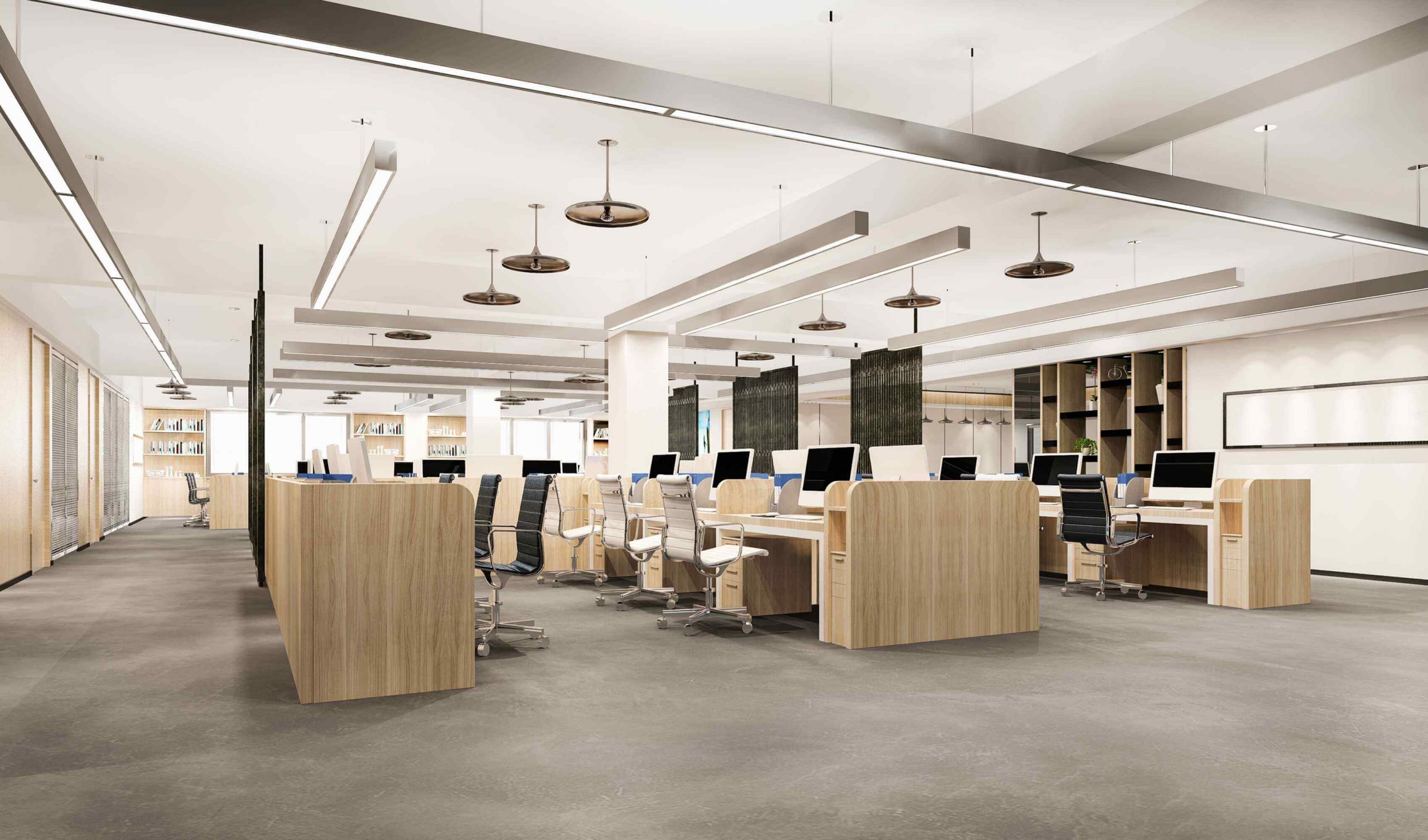The Evolution of Modern Office Spaces: How Design Affects Productivity
5 Mins Read
Published on: 28 February 2025
Last Updated on: 03 March 2025

toc impalement
- The recent research says that 70% of the employees feel more productive in an open workspace.
- The modern office spaces can easily boost employee satisfaction by upto 15%.
The modern office has undergone a significant transformation over the decades. It is adapting to new technologies, workforce expectations, and evolving business needs.
What was once a rigid, cubicle-dominated environment has shifted toward open-concept layouts, hybrid workspaces, and ergonomically designed interiors.
Companies today recognise that office design is crucial to employee productivity, engagement, and overall well-being.
An office structure can enhance focus and efficiency or create distractions and discomfort. Thus, it is necessary to understand the evolution of office spaces and their impact on productivity.
Furthermore, this helps businesses make informed decisions about workspace planning.
Organizations can foster an environment. They can focus on integrating modern trends that boost creativity and efficiency. These trends can include collaborative zones, natural lighting, flexible seating, and employee wellness initiatives.
This article explores the key changes in office design over time, how these modifications affect workplace performance, and what the future holds for office spaces.
The Modern Office spaces: Hybrid Workspaces And Sustainability
Modern workspaces are not places where you just work! It is more an environment that strongly fosters creativity, well-being, and collaboration.
The evolution of this office design is more like an approach towards creating a great space for better work-life balance and sustainability.
Here’s what you can find in modern Office spaces,
| Hybrid workspaces | These workspaces cater to both remote and in-office workers. |
| Sustainable designs | This is the new normal. The office spaces that use energy-efficient lighting and green certifications such as LEED. |
| Better employee well-being | These modern office spaces are designed while keeping wellness in mind. They incorporate natural light, ergonomic light, and even the relaxation area. |
| Technology-driven workspaces | The smart offices are created using AI-powered tools, IoT devices, and digital collaboration platforms. |
Creating a Productive Work Environment with Smart Office Features
One of the fundamental shifts in designs for modern office spaces is the focus on creating a comfortable and engaging work environment that meets employees’ needs.
Smart office features, such as ergonomic furniture, soundproof workspaces, and biophilic design, have been incorporated to optimise productivity.
Companies understand that providing an efficient workspace reduces fatigue, improves focus, and enhances overall job satisfaction.
A key element in designing a modern office is ensuring employees have access to amenities promoting well-being.
For example, water drinking fountains have become essential in offices, encouraging hydration and supporting overall health.
Simple additions like these contribute to employee wellness. It helps in enhancing cognitive function and work performance.
The Shift from Traditional to Open Office Spaces
Historically, office spaces were structured around a hierarchical model with private offices for executives and small cubicles for employees.
This layout was designed to promote individual focus while maintaining organisational structure.
However, this traditional setup often resulted in three ways:
- Isolation,
- Limited collaboration, and
- A rigid work atmosphere.
In contrast, introducing open office spaces aimed to promote interaction and teamwork. By removing barriers such as walls and cubicles, companies hoped to create a more dynamic and inclusive work environment.
Open layouts encourage:
- Communication,
- Foster creativity, and
- Make employees feel more connected.
However, this approach also introduced challenges such as increased noise levels and a lack of privacy, which can hinder deep focus and productivity.
Despite these drawbacks, businesses continue to refine open office concepts by incorporating designated quiet zones, meeting pods, and flexible seating arrangements.
The Rise of Flexible Workspaces and Hot Desking
As technology advances, employees no longer need to be tied to a specific desk or location to perform their duties.
This shift has led to flexible workspaces and hot desking, in which employees are not assigned seats but can choose where they work based on their daily tasks.
Flexible work environments provide several advantages. This includes
- Increased mobility,
- Better use of office space, and
- cost savings for companies.
They also cater to the growing trend of hybrid work models, in which employees split their time between home and the office. This setup allows businesses to downsize office space while maintaining efficiency.
However, hot desking also presents challenges. Some employees prefer having a dedicated workstation to personalise their setup, and the lack of consistency in seating arrangements can create a sense of detachment.
The Role of Natural Light and Green Spaces in Productivity
Natural light and greenery are significant factors in office design that directly impact employee productivity.
Studies have shown that exposure to natural light enhances mood, reduces stress, and improves concentration.
Modern Office spaces incorporate large windows, glass partitions, and skylights to maximize the benefits of natural light.
Additionally, including green spaces, such as indoor plants, vertical gardens, and outdoor break areas, has been linked to increased creativity and mental well-being.
The Influence of Ergonomics and Workplace Comfort
Office ergonomics are crucial to productivity and employee satisfaction. Poorly designed workstations can lead to discomfort, repetitive strain injuries, and decreased efficiency.
To combat these issues, businesses invest in ergonomic furniture, such as adjustable desks, lumbar-support chairs, and monitor stands.
Ergonomic solutions help employees maintain proper posture, reducing the risk of musculoskeletal problems and boosting overall comfort.
Additionally, businesses are incorporating standing desks and active seating options, which promote movement and prevent prolonged periods of inactivity.
The Impact of Office Acoustics on Focus and Efficiency
Noise levels in the workplace can significantly affect productivity, particularly in open office environments.
Excessive noise can lead to distractions, reduced concentration, and increased stress. Companies are integrating soundproofing solutions such as acoustic panels, noise-canceling workstations, and private meeting rooms. This can help them to mitigate these issues.
In addition to structural solutions, some offices implement sound-masking systems that create background white noise to drown out distractions.
Providing employees with noise-canceling headphones and establishing quiet zones further enhances concentration and work efficiency.
The Future of Office Spaces: A Hybrid and Tech-Driven Approach
As businesses continue to evolve, so does the concept of office spaces. The future workplace is expected to blend physical and digital elements. It helps in creating an environment that supports in-person and remote work.
Advanced technologies such as smart desks, AI-powered workspace management, and virtual reality meeting rooms will shape the next generation of office spaces.
Hybrid work models will remain a dominant trend, with businesses designing spaces that accommodate employees who work from home and the office.
The emphasis will be on creating adaptable environments that provide the flexibility needed for various work styles.
Overall, the evolution of modern office spaces reflects the changing needs of the workforce. From traditional cubicles to open layouts, flexible workstations, and tech-driven environments, office design continues to influence productivity and employee satisfaction.
Businesses prioritizing employee well-being, ergonomic solutions, natural lighting, and noise management create workspaces that foster efficiency and innovation.
YOU MAY ALSO LIKE:


















Comments Are Closed For This Article